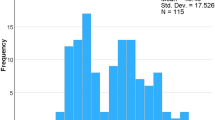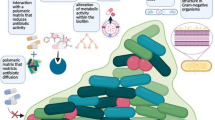Abstract
Background
Hyperglycemia is a risk factor for nosocomial infections with known host effects. Increased glucose levels also increase pathogenicity of infecting microbes through greater biofilm formation. The dose response of biofilm formation to glucose concentration is not known.
Questions/purposes
We asked: What is the relationship between the amount of biofilm formed by Staphylococcus epidermidis and Staphylococcus aureus and change in glucose concentration in the clinically important range of 20 to 300 mg/dL?
Methods
This experiment studied biofilm formation by S epidermidis and S aureus in Lennox broth medium supplemented with increasing glucose concentrations from 0 to 320 mg/dL in 20 mg/dL intervals. Biofilm was grown for 24 hours for S epidermidis and 48 hours for S aureus. Biofilms were heat fixed, stained with 0.1% crystal violet, and washed with deionized water. The dye was then extracted with 30% acetic acid. Visual light absorption of the extracted crystal violet dye at 600 nm was used to quantify the biofilm biomass. The effect of glucose concentration on the amount of biofilm mass produced was analyzed using ANOVA and Tukey’s test.
Results
Biofilm mass was increased at higher glucose concentration for both species with a threshold response at 0 to 20 and 160 to 200 mg/dL for S epidermidis and 200 to 240 mg/dL for S aureus.
Conclusions
Increased biofilm growth by S aureus and S epidermidis has a threshold response at clinically important concentrations.
Clinical Relevance
Postoperative hyperglycemia may increase the risk for implant infection through increased pathogenicity of intraoperative wound contaminants in addition to compromising host immune status.




Similar content being viewed by others
References
Abdallah DY, Jadaan MM, McCabe JP. Body mass index and risk of surgical site infection following spine surgery: a meta-analysis. Eur Spine J. 2013;22:2800–2809.
Agarwal A, Jain A. Glucose & sodium chloride induced biofilm production & ica operon in clinical isolates of staphylococci. Indian J Med Res. 2013;138:262–266.
Altman DG. Practical Statistics for Medical Research. 2nd ed. Boca Raton, FL: Chapman & Hall/CRC; 2006.
Arciola CR, Baldassarri L, Montanaro L. Presence of icaA and icaD genes and slime production in a collection of staphylococcal strains from catheter-associated infections. J. Clin Microbiol. 2001;39:2151–2156.
Arciola CR, Campoccia D, Gamberini S, Cervellati M, Donati E, Montanaro L. Detection of slime production by means of an optimised Congo red agar plate test based on a colourimetric scale in Staphylococcus epidermidis clinical isolates genotyped for ica locus. Biomaterials. 2002;23:4233–4239.
Beenken KE, Dunman PM, McAleese F, Macapagal D, Murphy E, Projan SJ, Blevins JS, Smeltzer MS. Global gene expression in Staphylococcus aureus biofilms. J Bacteriol. 2004;186:4665–4684.
Boles BR, Horswill AR. Agr-mediated dispersal of Staphylococcus aureus biofilms. PLoS Pathog. 2008;4:e1000052.
Brownlee M. Biochemistry and molecular cell biology of diabetic complications. Nature. 2001;414:813–820.
Campoccia D, Montanaro L, Arciola CR. The significance of infection related to orthopedic devices and issues of antibiotic resistance. Biomaterials. 2006;27:2331–2339.
Colombier S, Kessler U, Ferrari E, von Segesser LK, Berdajs DA. Influence of deep sternal wound infection on long-term survival after cardiac surgery. Med Sci Monit. 2013;19:668–673.
Croes S, Deurenberg RH, Boumans ML, Beisser PS, Neef C, Stobberingh EE. Staphylococcus aureus biofilm formation at the physiologic glucose concentration depends on the S. aureus lineage. BMC Microbiol. 2009;9:229.
Diefenbeck M, Mückley T, Hofmann GO. Prophylaxis and treatment of implant-related infections by local application of antibiotics. Injury. 2006;37(suppl 2):S95–S104.
Ee WW, Lau WL, Yeo W, Von Bing Y, Yue WM. Does Minimally Invasive Surgery Have a Lower Risk of Surgical Site Infections Compared With Open Spinal Surgery? Clin Orthop Relat Res. 2013 July 12 [Epub ahead of print].
Endara M, Masden D, Goldstein J, Gondek S, Steinberg J, Attinger C. The role of chronic and perioperative glucose management in high-risk surgical closures: a case for tighter glycemic control. Plast Reconstr Surg. 2013;132:996–1004.
Gillaspy AF, Hickmon SG, Skinner RA, Thomas JR, Nelson CL, Smeltzer MS. Role of the accessory gene regulator (agr) in pathogenesis of staphylococcal osteomyelitis. Infect Immun. 1995;63:3373–3380.
Hachiya H, Miura Y, Inoue KI, Park KH, Takeuchi M, Kubota K. Advanced glycation end products impair glucose-induced insulin secretion from rat pancreatic β-cells. J Hepatobiliary Pancreat Sci. 2014;21:134–141.
Kwasny SM, Opperman TJ. Static biofilm cultures of gram-positive pathogens grown in a microtiter format used for anti-biofilm drug discovery. Curr Protoc Pharmacol. 2010;Chapter 13:Unit 13A.8.
Nelson CL, Hickmon SG, Skinner RA. Treatment of experimental osteomyelitis by surgical debridement and the implantation of bioerodable, polyanhydride-gentamicin beads. J Orthop Res. 1997;15:249–255.
Pomposelli JJ, Baxter JK 3rd, Babineau TJ, Pomfret EA, Driscoll DF, Forse RA, Bistrian BR. Early postoperative glucose control predicts nosocomial infection rate in diabetic patients. JPEN J Parenter Enteral Nutr. 1998;22:77–81.
Regassa LB, Novick RP, Betley MJ. Glucose and nonmaintained pH decrease expression of the accessory gene regulator (agr) in Staphylococcus aureus. Infect Immun. 1992;60:3381–3388.
Reśliński A, Dabrowiecki S. [Evaluation of the effect of glucose on Staphylococcus aureus and Escherichia coli biofilm formation on the surface of polypropylene mesh] [in Polish]. Med Dośw Mikrobiol. 2013;65:19–26.
Søraas A, Sundsfjord A, Sandven I, Brunborg C, Jenum PA. Risk factors for community-acquired urinary tract infections caused by ESBL-producing Enterobacteriaceae—a case-control study in a low prevalence country. PloS One. 2013;8:e69581.
Tepper OM, Galiano RD, Capla JM, Kalka C, Gagne PJ, Jacobowitz GR, Levine JP, Gurtner GC. Human endothelial progenitor cells from Type II diabetics exhibit impaired proliferation, adhesion, and incorporation into vascular structures. Circulation. 2002;106:2781–2786.
Author information
Authors and Affiliations
Corresponding author
Additional information
Each author certifies that he or she, or a member of his or her immediate family, has no funding or commercial associations (eg, consultancies, stock ownership, equity interest, patent/licensing arrangements, etc) that might pose a conflict of interest in connection with the submitted article.”
All ICMJE Conflict of Interest Forms for authors and Clinical Orthopaedics and Related Research ® editors and board members are on file with the publication and can be viewed on request.
This work was performed at Banner Good Samaritan Medical Center, Phoenix, AZ, USA, and at Arizona State University, Tempe, AZ, USA.
About this article
Cite this article
Waldrop, R., McLaren, A., Calara, F. et al. Biofilm Growth Has a Threshold Response to Glucose in Vitro. Clin Orthop Relat Res 472, 3305–3310 (2014). https://doi.org/10.1007/s11999-014-3538-5
Published:
Issue Date:
DOI: https://doi.org/10.1007/s11999-014-3538-5




